Behavioral science raises first-order questions here. Thinkers like Daniel Kahneman, for instance, observe that we seem to function at two speeds: thinking fast (System-1) and thinking slow (System-2). The slow, deliberative process takes backseat to thinking fast, on the basis of heuristics and cognitive shortcuts. Most of our action decisions follow from System-1 processes and yet most management science is predicated on the belief that we routinely operate according to System-2.
And while I find it sad that this needs repeating over and again, we are motivated by far more than money. Status is important. Power is important. But above perhaps everything else is belonging. It is terrifying, at a profound and evolutionary level, to contemplate ostracism, rejection, ridicule. We are an “obligatorily gregarious species,” one for which evolutionary ‘fitness’ is defined at the group level, far more so than the individual level. It is part of our basic biology that we act to maintain belonging to those groups upon which we rely and to which we aspire.”
Q – Within banking there has been further investment in surveillance technology that is aimed at detection and by its very presence, deterrent. Yet here again, this seems to have only been successful in part. In your present capacity in running Starling, you have also embraced technologies but married them to your deep-rooted understanding and interest in human behaviour. How would you differentiate the pathway to risk mitigation you have developed embracing technology, as opposed to those already embedded in many (banks)?
A – “Surveillance and monitoring aims at creating a deterrent force, certainly. But a more direct purpose is to spot bad acts and to root out bad actors. In the banking sector, this approach to managing conduct risk is one I’ve termed “detect and correct.” It is by nature a backward looking exercise. But, in other industries, this is simply not an adequate standard of care. Think for instance of the nuclear power sector, aviation, Pharma. Do we want to rely on systems that spot trouble after it’s happened so we can send in the clean-up crew? No. In those industries, we insist on risk management capabilities that allow us to “predict and prevent” mishap. Why is this not the standard of care in the financial sector?
So, that’s a key distinction in what we’re doing at Starling. We are definitively not about surveillance and monitoring. We’re about assessing organizational predispositions towards certain action choices that directly impact performance — for good or ill. And we operate proactively, providing our customers with a predictive behavioral analytics platform that enables them to manage from the front-foot, whether with a view to optimizing performance (of a team, function, business unit, etc) or mitigating mission-critical behavioral risks.”
Q – What is the biggest challenge to adoption of such technologies that you see?
A – “Inertia. I think about the use of GPS systems (I think you call that Sat Nav in the UK). I grew up driving with reference to a paper map kept in the glovebox. Many of us who relied on that “tool” were resistant to adopting some new-fangled gizmo, that worked in ways we don’t understand, and which purport to know better than the map on which we’ve relied for decades, and successfully so, for the most part. My 83-year old father still insists on using a paper map when he drives somewhere new. But most of us have now adopted the GPS tool on our mobile devices, and rely on them almost unthinkingly. That will happen in the space we’re in — inevitably.”
Q – Similarly, I am interested from your international experiences and understanding of multiple and different regional and national cultures, if you see a difference in adoption in different regions? If so, can you give an insight and/or examples?
A – “I’ve worked on the ground in over 50-countries, and I’ve lived and worked for a number of years in Madrid, Frankfurt, London, and Shanghai, in addition to NY and Washington. I’m mindful of, and deeply appreciate, our distinct heritages and cultural traits. But, when it comes to behavior, we’re far more similar than we are different. This means that patterns of behavior are very likely to be highly consistent across national or cultural contexts. And this is true when it comes to adoption of any new technology: most people watch to see who goes first, and achieves success with these new tools, and then the laggards will follow on afterwards. I think we’re likely to see that typical “adoption curve” play out for our technology offerings in most markets.
That said, there are some that I think are more inclined the lean forward in this regard. I think here, for instance, about the use of behavioral science in the context of bank supervision that was pioneered by the Dutch Central Bank (DNB). The Monetary Authority of Singapore has carved out a meaningful leadership role in facilitating the trialing of new AI-based tools among the firms it oversees. The NY Fed has long been at the fore in calling on the industry to explore new thinking about managing culture and conduct risk. Under previous management, the UK’s Financial Conduct Authority also emphasized these changes in thinking, but the new leadership has been relatively silent so it remains to be seen what happens there.”
Q – How do you build the commercial case for adoption of such innovations in a cost contained environment?
A – “Gary Cohn, the former President and COO of Goldman Sachs, is an investor and close advisor to us at Starling. He’d argue it this way: “if you tell me you’re going to charge me $20 million to save me from a $2 billion fine, that’s a deal I’ll do any day.”
The fact is that, since the Financial Crisis, the industry has paid out some $800 billion (in the global aggregate) in punitive fines, customer remediation costs, and shareholder law suits. And that’s despite spending at least as much on their governance, risk and compliance infrastructure. So where’s the desired ROI in that scenario?
I’d turn your question on its head: what’s the commercial case for not adopting something that may produce more desirable outcomes? And particularly when regulators appear to look favorably on at least exploring what this new category of technology may permit. This is the kind of discussion being heard in more and more bank c-suites. There will be leaders and there will be followers, of course, as I said a moment ago. But regulators (and prosecutors) are very likely to take note and remember who led and who lagged.”
Q – Finally, as a student of human behaviour, what role does leadership, having an embedded purpose and values have in risk mitigation (that if married to technology) would enable business leaders to optimize business performance whilst minimising nonfinancial risk?
A – “I’d start with the purpose item, of necessity, in my view. What are we here to do? And why? If the answer is “to make as much money as possible for ourselves and our shareholders,” well, okay. But that doesn’t leave me with grounds to trust that you have my best interests at heart. So I won’t trust you. And the more pervasive that distrust, the more it detracts from your brand value.
If, however, we exist to serve some critical function — to cure cancer, to clean the environment, and, yes, to serve as a reliable intermediary that brings liquidity to the market — then your leadership needs to start from and serve that purpose, at all points. Your leaders need to embody and exemplify that purpose. And where that is the case, leaders will do all they can to optimize performance (for all stakeholders) and to minimize risk of failing in your purpose, in ways large or small.
We often hear that this mentality needs to be pushed down to the coal-face, to those on the first line, and to be thoroughly ‘embedded’ throughout the organization. With that comes the oft-stated view that managing culture and conduct related risks is “everyone’s job.” But when everyone is responsible, no one is. So, yes, these views need to permeate the organization. But someone has to sit at the Big Desk where the buck stops. To my mind, that simply must be the CEO, with direct involvement from the board. And as recent events reflect, regulators, investors, and employees would seem to be sympathetic with that view.”











